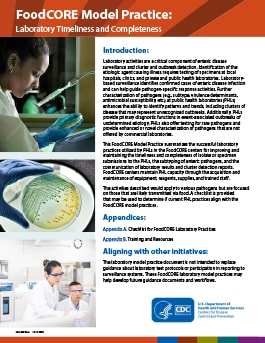Laboratory Timeliness and Completeness
Download a print version of the FoodCORE Model Practice: Laboratory Timeliness and Completeness [PDF – 9 pages]
Introduction
Laboratory activities are a critical component of enteric disease surveillance and cluster and outbreak detection. Identification of the etiologic agent causing illness requires testing of specimens at local hospitals, clinics, and private and public health laboratories. Laboratory-based surveillance identifies confirmed cases of enteric disease infection and can help guide pathogen-specific response activities. Further characterization of pathogens (e.g., subtype, virulence determinants, antimicrobial susceptibility, etc.) at public health laboratories (PHLs) enhances the ability to identify patterns and trends, including clusters of disease that may represent unrecognized outbreaks. Additionally, PHLs provide primary diagnostic functions in event-associated outbreaks of undetermined etiology. PHLs also offer testing for rare pathogens and provide enhanced or novel characterization of pathogens that are not offered by commercial laboratories.
This FoodCORE Model Practice summarizes the successful laboratory practices utilized by PHLs in the FoodCORE centers for improving and maintaining the timeliness and completeness of isolate or specimen submissions to the PHLs, the subtyping of enteric pathogens, and the communication of laboratory results and cluster detection reports. FoodCORE centers maintain PHL capacity through the acquisition and maintenance of equipment, reagents, supplies, and trained staff.
The activities described would apply to various pathogens but are focused on those that are likely transmitted via food. A checklist is provided that may be used to determine if current PHL practices align with the FoodCORE model practices.
Appendices
- Appendix A. [PDF – 41 KB] Checklist for FoodCORE Laboratory Practices
- Appendix B. [PDF – 120 KB] Training and Resources
Aligning with other initiatives
The laboratory model practice document is not intended to replace guidance about laboratory test protocols or participation in reporting to surveillance systems. These FoodCORE laboratory model practices may help develop future guidance documents and workflows.
Receiving and processing specimens
FoodCORE centers use various practices and systems to help ensure timely and complete submission of isolates/specimens from these external sources. These practices include:
- Utilizing data interoperability to accession isolates and specimens rapidly and accurately
- Rapidly transporting isolates/specimens to the PHL for testing to ensure prompt receipt of all requested or required bacterial, viral, or parasitic specimens from clinical and commercial laboratories
- Rapid transport can be supported with a variety of services such as the provision of mailing containers, a contract courier service, or other means of specimen transport to the PHL
- Transport time (e.g., collection date to received date at the PHL) should be monitored to identify gaps and areas for improvement
- Providing current guidance for
- Submitting patient, food, or environmental isolates/specimens to the PHL as part of routine surveillance and when investigating outbreaks, including outbreaks of undetermined etiology
- When and how to submit enrichment broths and other primary clinical specimens that are found positive by culture-independent diagnostic tests (CIDT) for Shiga toxin-producing E. coli (STEC) or other pathogens that meet submission requirements in your jurisdiction
FoodCORE centers also work closely with the clinical and commercial laboratories that submit specimens so any delays or gaps in submissions can be identified. Laboratory scientists at FoodCORE PHLs work with epidemiologists as needed to reach out to laboratories to encourage submissions and help eliminate barriers to submission if they are identified.
FoodCORE centers also conduct training for local health department (LHD) partners.1 As part of this training, submission protocol documents (manuals, standard operating procedure documents, etc.) and shipping materials can be provided to help ensure all partners know the testing capabilities of the PHL, what type of specimens should be collected, as well as when and how to collect and submit them to the PHL.
To help streamline the receipt and testing of specimens, outreach, resources, and training for clinical and commercial laboratories and LHD partners should include guidance stating that the PHL should be notified when specimens/samples will be submitted for outbreak investigations. PHLs should discuss capacity and prioritization with epidemiologists and environmental health partners during investigations where testing is needed, especially if a large number of environmental samples may require testing.
Subtyping specimens
Public health laboratories should reference current PulseNet Standard Operating Procedures (SOPs) and protocols for whole genome sequencing (WGS).

Reporting results and cluster detection
FoodCORE centers capitalize on the completeness and timeliness of specimen subtyping to quickly identify clusters of illness. All subtyping results are reported to the appropriate surveillance network in real-time whenever possible. To enhance reporting and cluster detection, FoodCORE centers use the following practices:
- Submitting all WGS data and metadata to the PulseNet national databases within 24 hours of results; submitting raw sequences to the National Center for Biotechnology Information (NCBI) for accessibility to those outside PulseNet
- Routinely analyzing subtyping data from PHL testing to determine if there is an increase of a specific subtype or strain
- Conducting surveillance and cluster detection using WGS data
- Following PulseNet’s recommended thresholds for detecting WGS clusters
- Look for three or more cases differing within 10 alleles by cgMLST, of which two differ within five alleles.2 Upload dates for all cases should be within the past 60 days of detection (120 days for Listeria). It is recommended that at least 30% of isolation dates fall within the past 50 days, except for Listeria.
- Utilizing the ‘Find Clusters Tool’ (as referenced in PulseNet SOPs and protocols) to detect local clusters
- Creating routine and ad hoc cgMLST dendrograms and/or similarity matrices to view allele differences
- Following PulseNet’s recommended thresholds for detecting WGS clusters
- Conducting surveillance and cluster detection using WGS data
- Routinely comparing subtyping results to centralized databases to determine whether there are additional subtype matches
- Utilizing subtyping results to link pathogens identified from product testing to persons infected with the same subtype or strain
- Utilizing shared data systems that permit routine rapid sharing of laboratory information and results for human, food, and environmental isolate testing to inform and facilitate response activities. These shared data systems allow for real-time sharing of specimen testing and subtyping information during an investigation:
- System for Enteric Disease Response, Investigation, and Coordination (SEDRIC)
- Utilizing SEDRIC to facilitate secure electronic data-sharing among partners during outbreak investigations. SEDRIC’s cluster detection tool enables users to set easy parameters to find clusters of isolates based on allele codes.
- Utilizing SEDRIC to visualize trees via NCBI’s Pathogen Detection Pipeline (see note under NCBI below)
- Utilizing SEDRIC’s Genomic Data Visualization Application to show the genotypic and phenotypic characteristics of a chosen group of isolates.
- NCBI
- Utilizing NCBI’s Pathogen Detection Pipeline (https://www.ncbi.nlm.nih.gov/pathogens/) to visualize trees (differences are in single nucleotide polymorphisms, or SNPs, not alleles)
- PulseNet SharePoint Site
- Posting initial clusters that have not already been coded by PulseNet at CDC and continuing their follow up even if they are not given an official outbreak code.
- Posting clusters with isolates, bundle files, and potential other state involvement as needed to identify additional isolates or common exposures. For example, cases clustering near a border to another state could be posted to request information on cases in the neighboring state.
- System for Enteric Disease Response, Investigation, and Coordination (SEDRIC)
- Routinely exchanging cluster detection reports
- At a minimum, weekly reporting with more frequent reporting (i.e., twice weekly, daily, etc.) if possible
- It is suggested that cluster detection reports describe:
- Number of isolates included
- Outbreak code (if available) and allele code(s) involved in the cluster (downloaded from the national database)
- Allele differences for the cluster
- Information regarding any relevant historical matches (past outbreaks, non-human, etc.)
- Matches in other states
- Genotyping information such as resistance or virulence data
- Line lists containing allele codes and relevant demographic information
- Dendrograms or similarity matrices
- It is suggested that cluster detection reports describe:
- Integrating reports with routine data analyses to determine if there is an increase in the number of cases of infection with a specific subtype or strain within your state
- Establishing methods for exchanging information about potential clusters that are detected between scheduled reports
- Having standing meetings and trainings that include laboratory and epidemiology staff so all staff have a working understanding of the needs and capabilities of each group and can interpret laboratory results with interview data
- Providing technical assistance to epidemiology staff on the interpretation of subtyping results, as needed
- At a minimum, weekly reporting with more frequent reporting (i.e., twice weekly, daily, etc.) if possible
Note
1 Epi-Ready Team Training. Integrated Food Safety Centers of Excellence. Accessed March 9, 2023. https://foodsafetycoe.org/product/1440/.
2 Some jurisdictions may use a narrower cluster definition that detects two or more clinical cases within 60 days.
